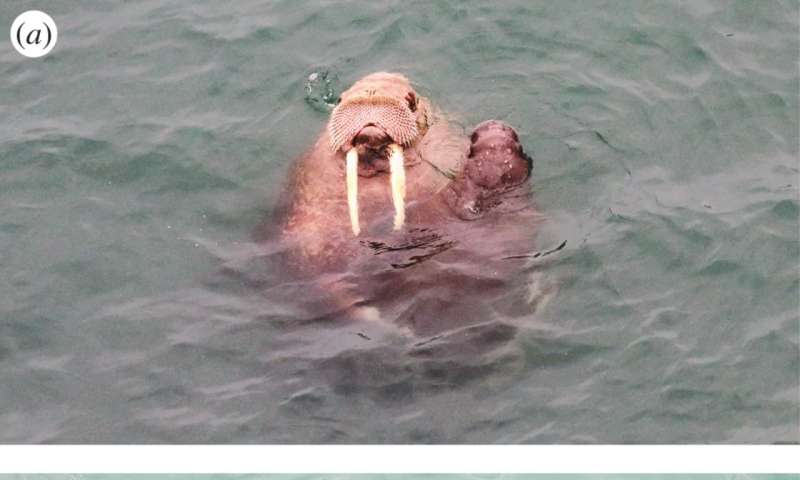January 10, 2018 report
Mother-child left-side face-to-face preference found to extend to walruses and Indian flying foxes

A team of researchers with Saint Petersburg State University and the Institute of Experimental Medicine, both in Russia, has found that a left-side face-to-face preference seen in primates also extends to non-primate marine and terrestrial mammals, specifically walruses and Indian flying foxes. In their paper published in the journal Biology Letters, the group describes their study of the two species and the interactions they witnessed between mothers and their offspring and what they learned by doing so.
Prior research has shown that human mothers favor a left-side approach when holding their babies face-to-face, meaning that both mother and child look to their left to see the other. Other research has shown that other primates also have a similar left-side face-to-face preference. Also, there has been some evidence showing that some non-primates also have a left-side preference in general, though not necessarily in face-to-face interactions. In this new effort, the researchers looked to find out if non-primate mammals do indeed have the same left-side face-to-face preferences as primates. To find out they chose to study one marine species and one terrestrial.
The team watched walruses in the wild interacting on Kolyuchin Island north of the Bering Strait. In all, 73 mothers were observed interacting with their offspring. They also ventured to Sri Lanka to watch Indian flying foxes interact with their young—they recorded the interactions of 226 pairs. The researchers report that they found a strong preference for mothers carrying their young in both species such that they would remain facing left when looking at each other face-to-face. The also found a strong preference in the young to keep the mother in their left-facing field of view when not being held. These findings, the researchers suggest, indicate that left-side preference in face-to-face mother-child interactions extends to non-primates.
While it has not been proven, it has been suggested that left-side preference aids in communication between mother and child because visual information from the left is processed in the right hemisphere of the brain, which prior research has shown is highly involved in processing social information. Some have also suggested that the left side of the face is more expressive. And now that it has been found to extend to non-primates, it appears likely, the researchers suggest, that the behavior has an ancient origin.
More information: Andrey Giljov et al. Facing each other: mammal mothers and infants prefer the position favouring right hemisphere processing, Biology Letters (2018). DOI: 10.1098/rsbl.2017.0707
Abstract
The right hemisphere plays a crucial role in social processing. Human mothers show a robust left cradling/holding bias providing greater right-hemispheric involvement in the exchange of social information between mother and infant. Here, we demonstrate that a similar bias is evident in face-to-face spatial interactions in marine and terrestrial non-primate mammals. Walruses and Indian flying foxes showed a significant population-level preference for the position which facilitates the use of the left visual field in both mother and infant. This behavioural lateralization may have emerged owing to benefits conferred by the enhanced right-hemispheric social processing providing the mother and infant an optimal perception of each other.
Journal information: Biology Letters
© 2018 Phys.org




















